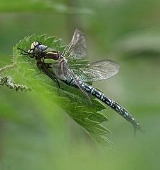
Hairy Dragonfly
Encyclopedia
Brachytron is a monophyletic genus of European dragonfly
of the family Aeshnidae
containing the Hairy Dragonfly (Brachytron pratense), also known as the Hairy Hawker.
, distinguishing it from other hawkers. It has a long, narrow pterostigma
(the coloured coloured, chitinous patch on the outer region of each wing).
The antehumeral stripes are usually thin and green. The Hairy Dragonfly has coupled, oval-shaped markings on its abdomen, blue on males and yellow on females. It is smaller than other species in the genus Aeshna
. It is the United Kingdom's smallest hawker.
Although it is a common species, it is susceptible to uncongenial ditch management and poor water conditions. The is the reason the species disappeared for a few years, only to return recently. More so then its other relatives, the Hairy Dragonfly will only fly in sunshine and will hastily retreat if the sun happens to go in.
Dragonfly
A dragonfly is a winged insect belonging to the order Odonata, the suborder Epiprocta or, in the strict sense, the infraorder Anisoptera . It is characterized by large multifaceted eyes, two pairs of strong transparent wings, and an elongated body...
of the family Aeshnidae
Aeshnidae
The hawkers include the largest dragonflies found in North America and Europe, and are among the largest of the dragonflies on the planet...
containing the Hairy Dragonfly (Brachytron pratense), also known as the Hairy Hawker.
Description
The Hairy Dragonfly is named for its hairy thoraxThorax
The thorax is a division of an animal's body that lies between the head and the abdomen.-In tetrapods:...
, distinguishing it from other hawkers. It has a long, narrow pterostigma
Pterostigma
The pterostigma is a cell in the outer wing of insects which is often thickened or coloured and so stands out from other cells. It is particularly noticeable in dragonflies, but present also in other insect groups, such as snakeflies, hymenopterans and megalopterans.The purpose of the pterostigma,...
(the coloured coloured, chitinous patch on the outer region of each wing).
The antehumeral stripes are usually thin and green. The Hairy Dragonfly has coupled, oval-shaped markings on its abdomen, blue on males and yellow on females. It is smaller than other species in the genus Aeshna
Aeshna
Aeshna is the scientific name of a genus of dragonflies from the family Aeshnidae. They are also known as hawker dragonflies, or, in North America, as mosaic darners.-Description:These are relatively large dragonflies...
. It is the United Kingdom's smallest hawker.
Habitat
The Hairy Dragonfly lives in ponds, lakes, fens, ditches, and canals rich in vegetation. Some plants that grow there include the common club rush, common reed, great fen sedge, and true bulrush. This dragonfly requires open and sunny areas with dense vegetation for protection. Here they are able to feed on flying insects, shelter, and grow sexually mature.Although it is a common species, it is susceptible to uncongenial ditch management and poor water conditions. The is the reason the species disappeared for a few years, only to return recently. More so then its other relatives, the Hairy Dragonfly will only fly in sunshine and will hastily retreat if the sun happens to go in.

